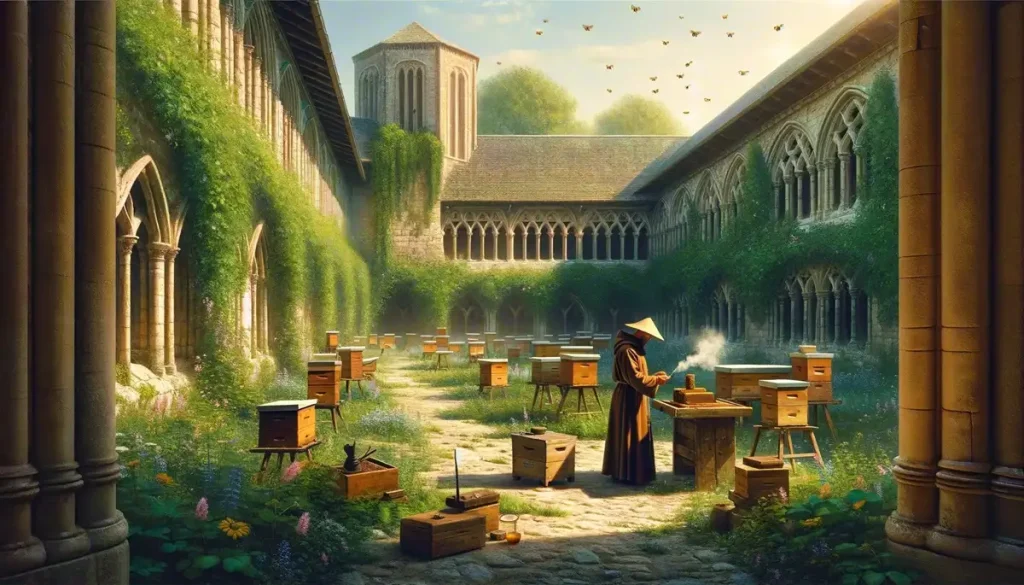Table of Contents
Once upon a time, in a world abuzz with ingenuity, beekeeping, and hence the history of beekeeping, came to be. Imagine yourself lounging in the garden on a sun-soaked afternoon enjoying a delectable honey-infused treat while observing some bees diligently working away, pollinating blossoms and creating the amber elixir we all adore. Now, picture the very first humans who chanced upon these tiny yet hardworking insects and unearthed the sweet fortune they bestowed.
In this delightful journey through the ages, we’ll explore the art and science of beekeeping from its humble beginnings in ancient civilizations to the innovative and eco-friendly practices of today. Uncover the secrets of those honey hunters who braved the wilds and faced stinging adversaries, all in the pursuit of nature’s liquid gold. I’ll also uncover the important role bees have played in our history.
Get ready to dive headfirst into the world of apiculture, where you’ll learn not only about the fascinating past of beekeeping but also about the essential role bees play in our ecosystem. So grab your beekeeper suit (metaphorically speaking) and let’s embark on a buzz-worthy adventure together!
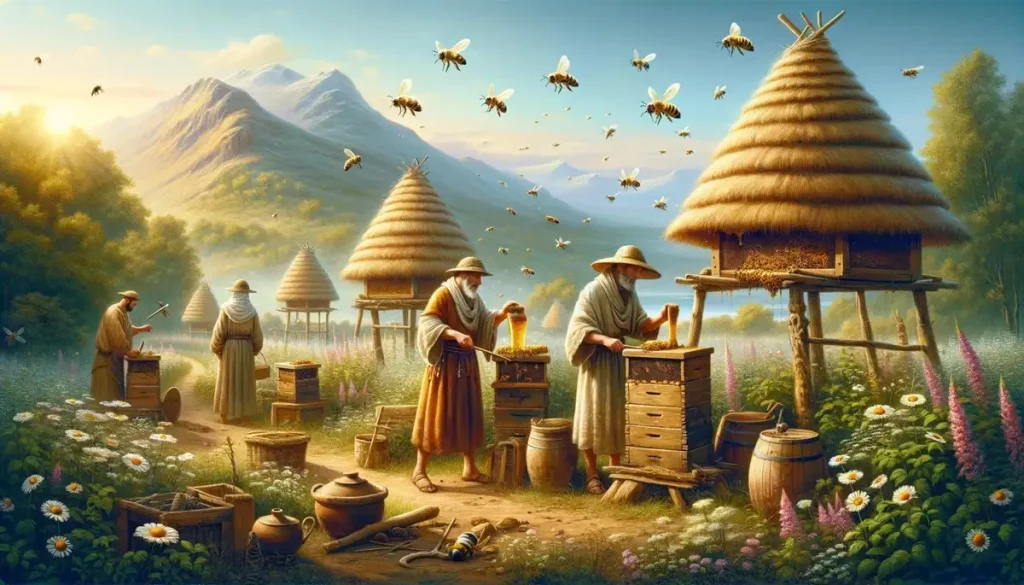
The Early History Of Beekeeping
The history of beekeeping dates back to ancient times, with evidence of early beekeeping practices found in various cultures throughout the world.
Beekeeping in Ancient Egypt
The Egyptians were one of the earliest known civilizations to keep bees, and they were known for their sophisticated honey production techniques. Honey was used for both medicinal and culinary purposes and was even used to embalm the dead.
Beekeeping in Ancient Greece
In Greece, beekeeping was also an important practice, and Aristotle was one of the first to write about bees and their behavior. The ancient Greeks believed that bees were divine creatures, and the honey they produced was considered a gift from the gods. Greek beekeepers used simple, yet effective techniques, such as straw baskets and clay pots, to house their bees.
Beekeeping in Ancient Rome
The Romans were also skilled beekeepers, and they used honey for a wide range of purposes, from cooking and medicine to cosmetics and religious rituals. Roman beekeepers used cylindrical hives made from woven twigs or wicker, and they placed these hives in protected areas, such as courtyards or gardens, to keep the bees safe.
Ancient Beekeeping in Other Cultures
Ancient beekeeping practices were not limited to the Egyptians, Greeks, and Romans; they were also prevalent in various cultures across Asia and Africa.
Beekeeping in Ancient China
For instance, in ancient China, beekeeping dates back to at least the 7th century BCE. The Chinese valued honey for its medicinal properties and used it in traditional medicine to treat a range of ailments. They also recognized the importance of bees in the pollination process, which contributed to the development of their agriculture. Early Chinese beekeepers utilized simple hives, often made from wood or clay, and applied smoke to subdue the bees when harvesting honey.
Beekeeping in Ancient Africa
In Africa, evidence of beekeeping has been found in various regions, such as Ethiopia, where traditional beekeeping methods have been practiced for centuries. Ethiopian beekeepers used hives made from local materials, such as hollowed-out logs or woven baskets, and placed them high in trees to protect the bees from predators. Honey played a significant role in African culture, with its use in food, traditional medicine, and as an ingredient in honey wine, known as tej. The indigenous knowledge and techniques used by these early beekeepers have been passed down through generations and continue to influence modern beekeeping practices in these regions.
The inclusion of beekeeping practices from Asia and Africa in the early history of beekeeping offers a more comprehensive and diverse perspective on the development and significance of beekeeping across different civilizations. By examining these ancient practices, we can gain a deeper understanding of the various techniques, innovations, and cultural influences that have shaped the art and science of beekeeping throughout history.
Historical Importance of Beekeeping
Beekeeping during these early civilizations was a crucial practice, not only for the production of honey and beeswax but also for the important role that bees played in pollination. Bees were essential for the pollination of fruits, vegetables, and other crops, making them an important part of agriculture and food production.
- Carter, Anthony (Author)
- English (Publication Language)
- 194 Pages - 02/28/2024 (Publication Date) - Independently published (Publisher)
Early Beekeeping Techniques
Beekeepers during these times used simple, yet effective techniques to manage their bees. They understood the importance of keeping the bees healthy and safe, and they took great care in protecting them from predators and diseases. Although the equipment and techniques used by early beekeepers were primitive compared to modern standards, their knowledge and understanding of bees laid the foundation for the development of modern beekeeping practices.
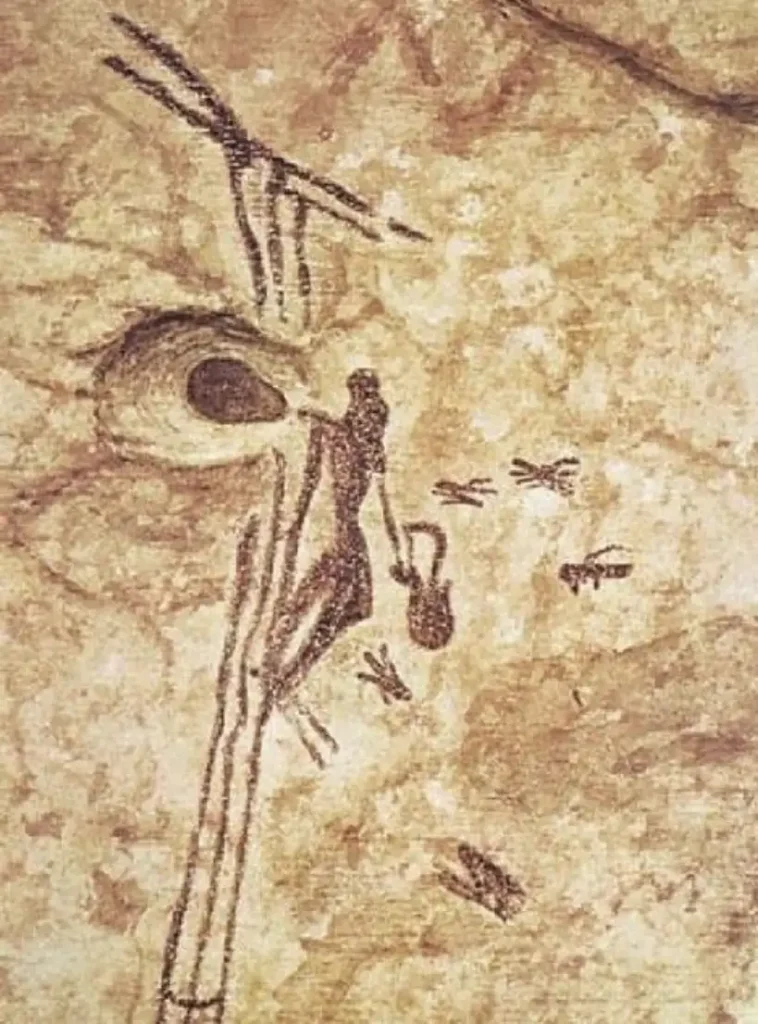
Historical Beekeeping Tools and Equipment
The tools and equipment used by early beekeepers were relatively simple but effective in managing their hives and harvesting honey. Understanding the historical development of these tools provides insights into how beekeeping techniques evolved over time and how they laid the groundwork for modern beekeeping practices.
Tools and Equipment in Ancient Egypt
In ancient Egypt, beekeepers used smoke to calm the bees while they harvested honey from simple hives made of clay or mud. They also used long, curved knives to cut the honeycombs from the hives, which were then placed in woven baskets or pottery for storage and transportation. Additionally, the Egyptians created early forms of honey extractors made from clay, which allowed them to separate the honey from the honeycomb more efficiently.
Tools and Equipment in Ancient Greece and Rome
The Greeks and Romans used similar tools, such as smoke to calm bees and simple knives to cut honeycombs. However, their hives were different, with the Greeks utilizing straw baskets and clay pots, while the Romans used cylindrical hives made from woven twigs or wicker. Both cultures also used honey presses to extract honey from the comb, which were an improvement over the Egyptian clay extractors.
Tools and Equipment in Medieval Europe
During medieval times in Europe, beekeepers used skeps, straw baskets that housed bees, which were both effective and affordable. However, harvesting honey from a skep often resulted in the destruction of the hive, as beekeepers had to cut open the skep to access the honeycomb. To protect themselves from bee stings, beekeepers used simple protective clothing made from cloth or leather and used veils made from woven materials or netting to cover their faces.
Tools and Equipment in the Renaissance
With the invention of the moveable comb hive in the Renaissance, beekeeping tools began to evolve rapidly. Beekeepers started using specialized tools such as hive tools for prying apart frames, bee brushes for gently removing bees from the comb, and smokers with bellows for easier smoke application.
The evolution of beekeeping tools and equipment reflects the growing understanding of bees and their behavior, as well as the drive to make beekeeping more efficient and sustainable. Early beekeeping tools, although simple and rudimentary compared to modern equipment, laid the foundation for the development of today’s sophisticated and specialized beekeeping tools, which have ultimately revolutionized the industry.
The Role of Honey and Beeswax in Ancient Trade
Honey and beeswax have been highly valued commodities since ancient times, playing a crucial role in trade between civilizations. The widespread use of honey as a sweetener and preservative, as well as the importance of beeswax for making candles and various other products, made these goods essential for many societies. As a result, the trade of honey and beeswax contributed significantly to the economies of ancient civilizations and fostered relationships between different cultures.
Trade in Ancient Egypt
In ancient Egypt, honey was regarded as a luxury item, often reserved for the elite and used in religious ceremonies. Egyptian honey was traded throughout the Mediterranean region, with its high quality and scarcity making it a sought-after commodity. Beeswax was also an important export, as it was used in the production of cosmetics, medicinal ointments, and, most importantly, candles. The Egyptians had a well-established trade network that allowed them to export honey and beeswax to other regions, such as the Levant and Mesopotamia, in exchange for valuable goods like spices, textiles, and precious metals.
Trade in Ancient Greece
Similarly, the ancient Greeks were renowned for their honey, particularly the thyme honey produced in Attica. Greek honey and beeswax were traded across the Mediterranean and the Black Sea, contributing to the wealth of city-states like Athens. Honey was a staple in Greek cuisine and was believed to possess medicinal and healing properties. Beeswax was used for various purposes, including crafting bronze statues and creating encaustic paintings, a technique that involved mixing pigments with melted beeswax.
Trade During the Middle Ages
During the Middle Ages, the trade of honey and beeswax continued to play an important role in European economies. Monasteries and convents, as centers of beekeeping, were instrumental in producing and trading honey and beeswax, which generated income to support their religious activities. Beeswax candles were particularly valuable, as they were required for use in churches and by the nobility.
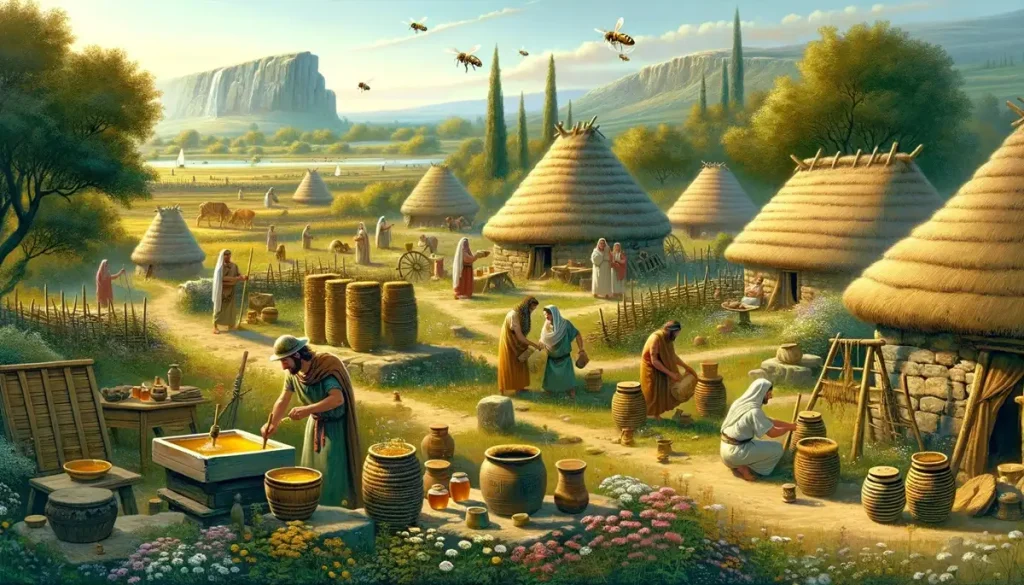
The Role of Religion and Mythology in Beekeeping
The role of religion and mythology in beekeeping has significantly influenced the cultural importance of bees and shaped early beekeeping practices across various civilizations. Bees and honey have often been associated with divine qualities, making their presence essential in religious and mythological narratives.
Egyptian Culture and Beekeeping
In ancient Egypt, bees were considered sacred and believed to have originated from the tears of the sun god, Ra. Honey played a vital role in religious rituals, such as offerings to the gods, and was used as a symbol of resurrection and immortality. This reverence for bees in Egyptian culture contributed to the development of their sophisticated beekeeping techniques.
Greek Mythology and Beekeeping
In Greek mythology, bees were often associated with nymphs, who were believed to take the form of bees and provide honey as a divine gift. The Greek god Zeus was said to have been fed honey by bees while hidden away in a cave during his infancy. Additionally, the ancient Greeks believed that bees had a special connection to the muses, the goddesses of inspiration and creativity. This reverence for bees in Greek culture inspired the development of beekeeping practices and the use of honey in various aspects of life.
Hinduism and Beekeeping
In Hinduism, the god Vishnu is often depicted as resting on a lotus flower surrounded by bees. Honey is considered one of the five sacred substances, or panchamrita, used in Hindu rituals. Furthermore, in ancient Indian texts, bees are associated with wisdom and knowledge, and honey is often used as a metaphor for the sweetness of spiritual knowledge.
Celtic Mythology and Beekeeping
Celtic mythology also holds bees in high regard, with the bee representing wisdom, community, and hard work. In Irish folklore, bees were believed to have supernatural powers, and the Celts considered honey a symbol of abundance and prosperity. This reverence for bees in Celtic culture contributed to the development of beekeeping practices in medieval Ireland and other Celtic regions.
The association of bees with divine and mythological attributes across various cultures highlights their cultural importance and helps explain the widespread adoption of beekeeping practices throughout history. By understanding the role of religion and mythology in beekeeping, we gain valuable insights into the beliefs and values that have shaped the practice and contributed to its continued significance in modern times.
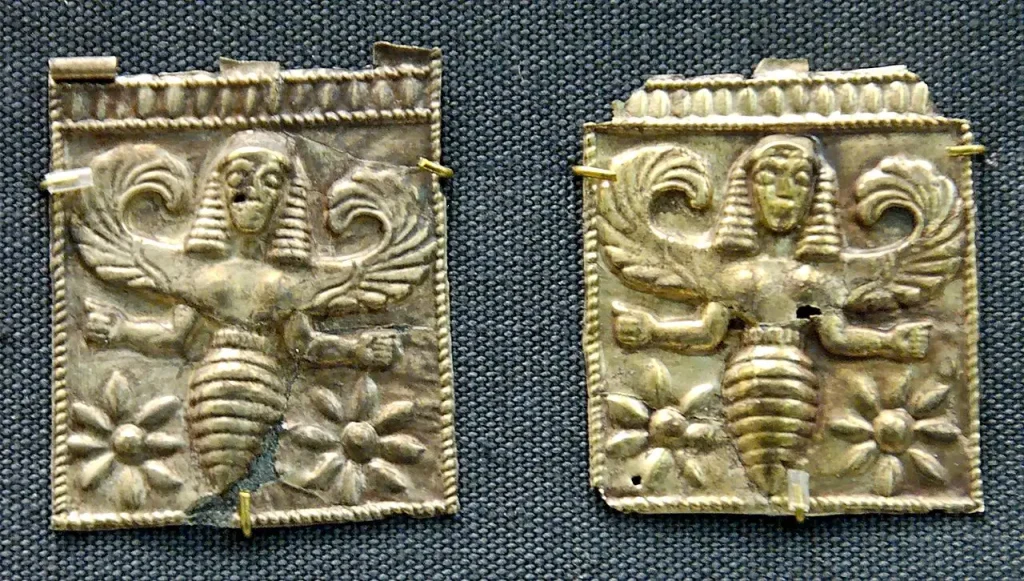
The Role of Bees in Art and Literature
Bees have been a recurring theme in art and literature throughout history, symbolizing various qualities such as diligence, community, and even divine inspiration. The depiction of bees and beekeeping in different forms of artistic expression provides interesting insights into the cultural significance of these fascinating creatures and their impact on human societies.
Bees in Ancient Greece
In ancient Greece, bees were frequently associated with the arts, particularly poetry and music. The Greeks believed that bees were divine messengers and that honey was a gift from the gods. They considered bees as symbols of eloquence and wisdom. This connection is exemplified in the myth of the Greek god Apollo, who was said to have been fed honey by bees as an infant, granting him the gift of prophecy and the ability to speak in beautiful, poetic language. As a result, ancient Greek poets, such as Pindar, often referred to themselves as “honey-tongued” and drew inspiration from the industrious and harmonious nature of bees in their works.
Bees in Visual Arts
In visual arts, bees have been a popular motif for centuries. Ancient Egyptian art often depicted bees in various forms, including as hieroglyphs representing royalty and power. Bees also featured in Roman mosaics and frescoes, often symbolizing abundance, fertility, and the harmony of nature. In medieval Europe, illuminated manuscripts and religious art incorporated bees as symbols of hard work, piety, and community. Later, during the Renaissance and Baroque periods, artists continued to feature bees in their paintings and sculptures, both as allegorical symbols and as detailed studies of nature.
Bees in Literature
In literature, bees have been the subject of fables, poems, and allegories, serving as vehicles for moral lessons and reflections on human behavior. Aesop’s fables, for example, include several stories featuring bees, emphasizing the virtues of hard work and cooperation. In more modern times, authors such as Sylvia Plath, Emily Dickinson, and Virginia Woolf have drawn inspiration from bees and used them as metaphors in their literary works.
The presence of bees in art and literature throughout history highlights the deep cultural significance of these creatures and their role in human societies. Their symbolic meanings and the qualities they represent continue to captivate and inspire artists, writers, and audiences alike, attesting to the enduring fascination with bees and the importance of beekeeping.
Beekeeping in the Middle Ages
Beekeeping in the Middle Ages was an important practice, as honey served as a primary sweetener and beeswax was essential for making candles. The demand for honey and beeswax made beekeeping a valuable industry during this time, and its practitioners developed unique methods and techniques to manage their hives.
The Monastery and Convent Association
During the Middle Ages, beekeeping was often associated with monasteries and convents, where monks and nuns tended to the hives as part of their daily tasks. They used the honey in their own kitchens and sold the surplus to generate income for their religious institutions. Beeswax candles were highly sought after, as they produced less smoke and odor compared to those made from animal fat, and they were a requirement for use in churches.
Skeps: The Traditional Hive
Beekeepers in the Middle Ages used skeps, which were dome-shaped baskets made of straw, to house their bees. These skeps provided a dark and sheltered environment for the bees to build their honeycomb. However, skeps had some limitations, as they made it difficult for beekeepers to inspect the interior of the hive and monitor the health of the colony. Harvesting honey from skeps often involved cutting open or breaking apart the basket, which destroyed the hive and sometimes resulted in the loss of the bee colony.
Traditional Methods of Swarm Capture
Medieval beekeepers relied on natural methods to attract and capture swarms of bees. They often used scents such as crushed herbs or honeycomb to lure bees to their skeps. Once a swarm had settled in a skep, the beekeeper would carefully move it to a designated apiary or garden where the bees could forage for nectar and pollen.
Protective Clothing and Practices
To protect themselves from bee stings, medieval beekeepers wore simple protective clothing made from cloth or leather. They also used veils made from woven materials or netting to cover their faces. Smoke was used to calm the bees during the honey harvest, a practice that is still common in modern beekeeping.
The Legacy of Beekeeping in the Middle Ages
Despite the challenges posed by the limited tools and equipment of the time, beekeeping in the Middle Ages was a vital practice that supported both religious institutions and local communities. The use of skeps and traditional techniques laid the foundation for future innovations in beekeeping, paving the way for the development of more advanced methods and tools that would revolutionize the industry in the centuries to come.
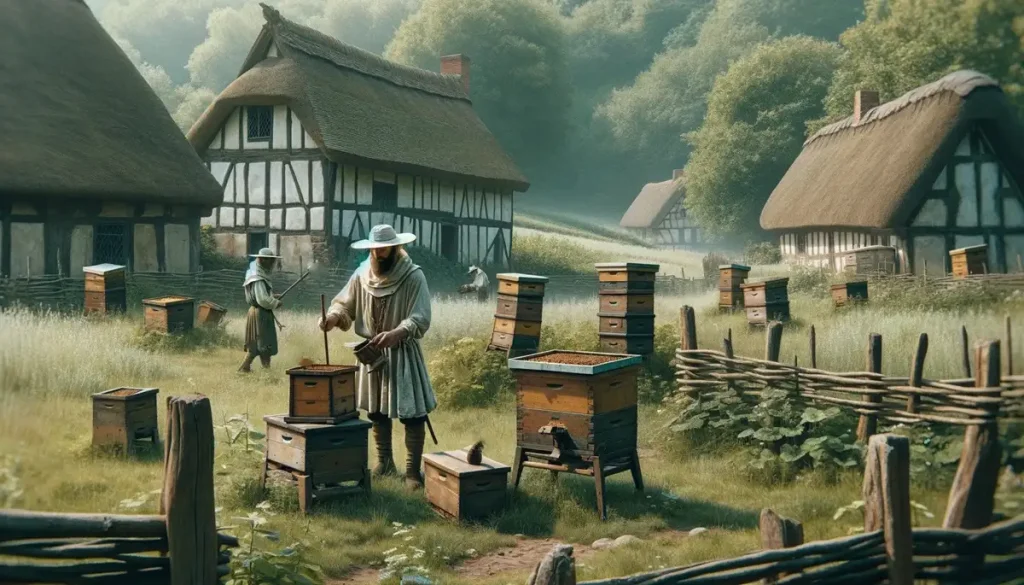
The Evolution Of Beekeeping In Europe
Beekeeping in Europe has a rich and fascinating history, with its roots stretching back to medieval times. During this era, honey was a highly valuable commodity, and beekeeping became an important industry. Beekeepers during the medieval period used skeps, which are simple, straw baskets that were used to house bees. Skeps were an effective way to keep bees, but they were difficult to manage, as it was challenging to inspect the hive and collect honey without disturbing the bees.
Renaissance: Innovations in Beekeeping
In the Renaissance, innovations in beekeeping began to emerge, which helped to improve beekeeping methods and increase honey production. One of the most significant innovations was the development of the moveable comb hive, which allowed beekeepers to inspect the hive without disturbing the bees. This invention made beekeeping more efficient and productive, as it enabled beekeepers to extract honey without destroying the comb. The moveable comb hive was a game-changer for beekeeping, and it revolutionized the industry.
Industrial Revolution: Further Advancements in Beekeeping
The Industrial Revolution brought about further advancements in beekeeping, with the invention of new tools and equipment that helped to make beekeeping more efficient. The honey extractor, for example, was a significant development that allowed beekeepers to extract honey from the comb without destroying it. This invention made honey production more efficient, and it enabled beekeepers to extract more honey than ever before.
North America: A New Form of Beekeeping
European beekeeping eventually made its way to North America, where it took on a new form. In the United States beekeeping became an important industry, with honey production and pollination becoming a crucial part of agriculture. American beekeepers developed new techniques, such as migratory beekeeping, which involved moving hives from place to place to take advantage of different flowering seasons. They also developed new breeds of bees that were better suited to the North American climate.
The evolution of beekeeping in Europe has been a long and storied history, with many innovations and developments that have helped to shape the industry. From the simple skeps of medieval times to the modern hives of today, beekeeping has come a long way, and it continues to evolve and adapt to new challenges and opportunities.
The Development Of Modern Beekeeping
Today, beekeeping is a sophisticated and complex industry, with many advances in equipment and techniques that have revolutionized the practice. Modern beekeeping methods include the use of protective clothing, smoke to calm the bees, and sophisticated hives that allow beekeepers to monitor and manage their hives more effectively.
Protective Clothing
One of the most important developments in modern beekeeping is the use of protective clothing. Beekeepers today wear protective suits, gloves, and veils to protect themselves from bee stings. This protective clothing makes it possible for beekeepers to work safely and efficiently around their bees.
The Use of Smoke
Another significant development in modern beekeeping is the use of smoke to calm the bees. When a beekeeper uses a smoker, they can create a gentle smoke that calms the bees and makes them less likely to sting. This allows the beekeeper to work with the bees more easily, without causing them undue stress.
Sophisticated Hives
Modern beekeeping also involves the use of sophisticated hives that allow beekeepers to monitor and manage their hives more effectively. These hives are designed to be more efficient and productive than traditional hives, and they make it easier for beekeepers to extract honey and manage their colonies.
The Importance of Bees
Bees play a crucial role in pollinating crops and producing honey, making them an essential part of modern agriculture. Beekeepers today understand the importance of preserving and protecting honeybee populations, and they take great care to ensure the health and well-being of their bees. They also play an important role in educating the public about the importance of bees in agriculture and the ecosystem.
The development of modern beekeeping has been significant, with many advances in equipment and techniques that have revolutionized the practice. Beekeepers today have a deep understanding of bees and their behavior, and they use this knowledge to manage their colonies more effectively. Bees play a crucial role in modern agriculture, and beekeepers have an important responsibility to protect and preserve honeybee populations.
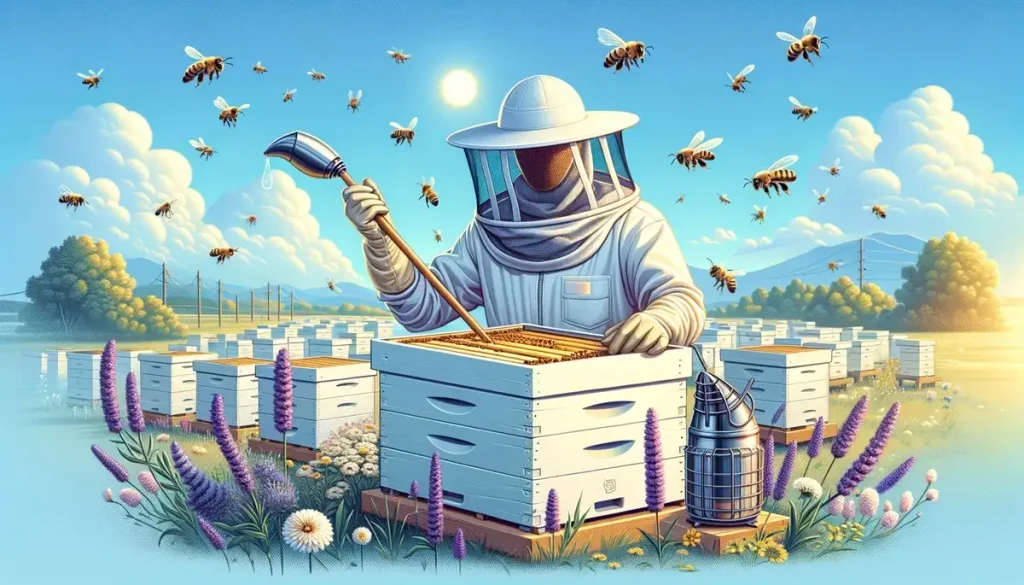
Beekeeping Organizations and Societies
The historical development of beekeeping organizations and societies has played a significant role in the growth and evolution of beekeeping as a profession and industry. These organizations have fostered the exchange of knowledge and expertise among beekeepers, promoted best practices, and advocated for the interests of both bees and beekeepers. The establishment of such organizations can be traced back several centuries, reflecting the long-standing importance of beekeeping in various cultures.
European Beekeeping Societies
In Europe, the emergence of beekeeping societies can be traced back to the 18th and 19th centuries. During this period, the scientific understanding of bees and beekeeping expanded, and the need for organized bodies to support beekeepers became apparent. One of the earliest known beekeeping societies was the British Beekeepers’ Association, founded in 1874. This organization aimed to promote the advancement of beekeeping knowledge and the improvement of beekeeping practices. In the following decades, similar organizations emerged throughout Europe, such as the Swiss Beekeepers’ Association and the German Beekeepers’ Association.
American Beekeeping Associations
In the United States, the first beekeeping organization was established in the late 19th century. The American Beekeeping Federation, founded in 1876, was created to support the growing industry and to provide a platform for beekeepers to exchange information and resources. Over time, numerous state and regional beekeeping associations were established, such as the California State Beekeepers Association and the Eastern Apicultural Society. These organizations helped to shape the development of beekeeping in the United States by fostering cooperation among beekeepers and promoting scientific research and innovation in the field.
Influence on Policies and Regulations
Beekeeping organizations and societies have also been instrumental in influencing policies and regulations related to the industry. Through their collective efforts, these organizations have advocated for the protection of bees and their habitats, as well as the rights and interests of beekeepers. They have played a key role in raising awareness about the challenges facing bee populations, such as the effects of pesticides, habitat loss, and disease, and have pushed for legislation and regulations to address these issues.
Challenges Facing Modern Beekeeping
Despite the many advances in beekeeping, the industry faces several challenges that threaten the health and well-being of honeybee populations. One of the most significant challenges facing beekeepers today is pests and diseases, such as varroa mites and colony collapse disorder.
Pests and Diseases
Varroa mites are a parasite that feed on honeybees, weakening their immune systems and making them more susceptible to other diseases. They are a major problem for beekeepers, as they can decimate entire colonies if left untreated. Another significant threat to honeybees is colony collapse disorder, a phenomenon where entire colonies of bees disappear or die off.
Chemicals
Chemicals, such as pesticides and herbicides, also pose a risk to bees. These chemicals can weaken or kill bees, making them more vulnerable to pests and diseases. Pesticides and herbicides are used extensively in modern agriculture, and they can be found in the pollen and nectar that bees collect. This means that bees are exposed to these chemicals on a regular basis, which can have serious consequences for their health.
Proactive Beekeeping
Beekeepers play a crucial role in preserving honeybee populations and protecting them from these threats. By monitoring their hives for signs of disease and infestation, beekeepers can take proactive measures to prevent or control these problems. They can also use organic and natural methods to control pests and diseases, such as essential oils and natural beekeeping practices.
Education
Beekeepers also play an important role in educating the public about the importance of honeybees and their role in agriculture. By raising awareness about the threats facing honeybee populations, beekeepers can help to promote the preservation and protection of these valuable creatures.
Overcoming the Challenges
The challenges facing modern beekeeping are significant, but they can be overcome through a combination of proactive management, natural methods, and education. Beekeepers play a crucial role in preserving honeybee populations, and they must continue to adapt and innovate in the face of new threats and challenges. By working together and sharing their knowledge and expertise, beekeepers can ensure that honeybees remain a vital part of our world.
The Future of Beekeeping
As beekeepers, we must continue to look for ways to improve the health and vitality of honeybee populations. The future of beekeeping will be shaped by ongoing research and technological advancements that are providing new tools and techniques for beekeepers to use in their practice.
New Treatments for Pests and Diseases
One area of focus in beekeeping research is the development of new treatments for pests and diseases. Scientists are working to develop new and innovative ways to control pests and diseases, such as breeding bees that are naturally resistant to pests and using new, non-toxic treatments.
Technological Advancements
Advancements in technology are also transforming the way that beekeepers manage their hives. For example, new monitoring systems are being developed that use sensors to track the health of hives and detect early signs of disease or infestation. These systems can alert beekeepers to potential problems before they become serious, which can help to prevent the spread of pests and diseases.
Sustainable Beekeeping Practices
Beekeepers are also looking for new ways to promote sustainable beekeeping practices that can help to protect and preserve honeybee populations. This includes reducing the use of chemicals and pesticides in beekeeping, as well as promoting natural beekeeping practices that are less harmful to bees and their habitat.
Education and Awareness
Education and awareness are also key to the future of beekeeping. Beekeepers must continue to raise awareness about the importance of honeybees in agriculture and the ecosystem, and to promote sustainable beekeeping practices that can help to preserve honeybee populations.
Promising Future
The future of beekeeping is full of promise and potential, as researchers and beekeepers work together to develop new tools and techniques to improve the health and vitality of honeybee populations. By promoting sustainable beekeeping practices and raising awareness about the importance of bees, we can ensure that honeybees remain an essential part of our world.
The History of Beekeeping – Conclusion
The history of beekeeping is rich and complex, and it has played a crucial role in human history. As beekeepers, we have a responsibility to preserve and protect honeybee populations, and to continue to look for ways to improve the health and vitality of our bees. By working together and sharing our knowledge and expertise, we can ensure that beekeeping remains an important part of our lives and our world.
Last update on 2024-04-25 / Affiliate links / Images from Amazon Product Advertising API

